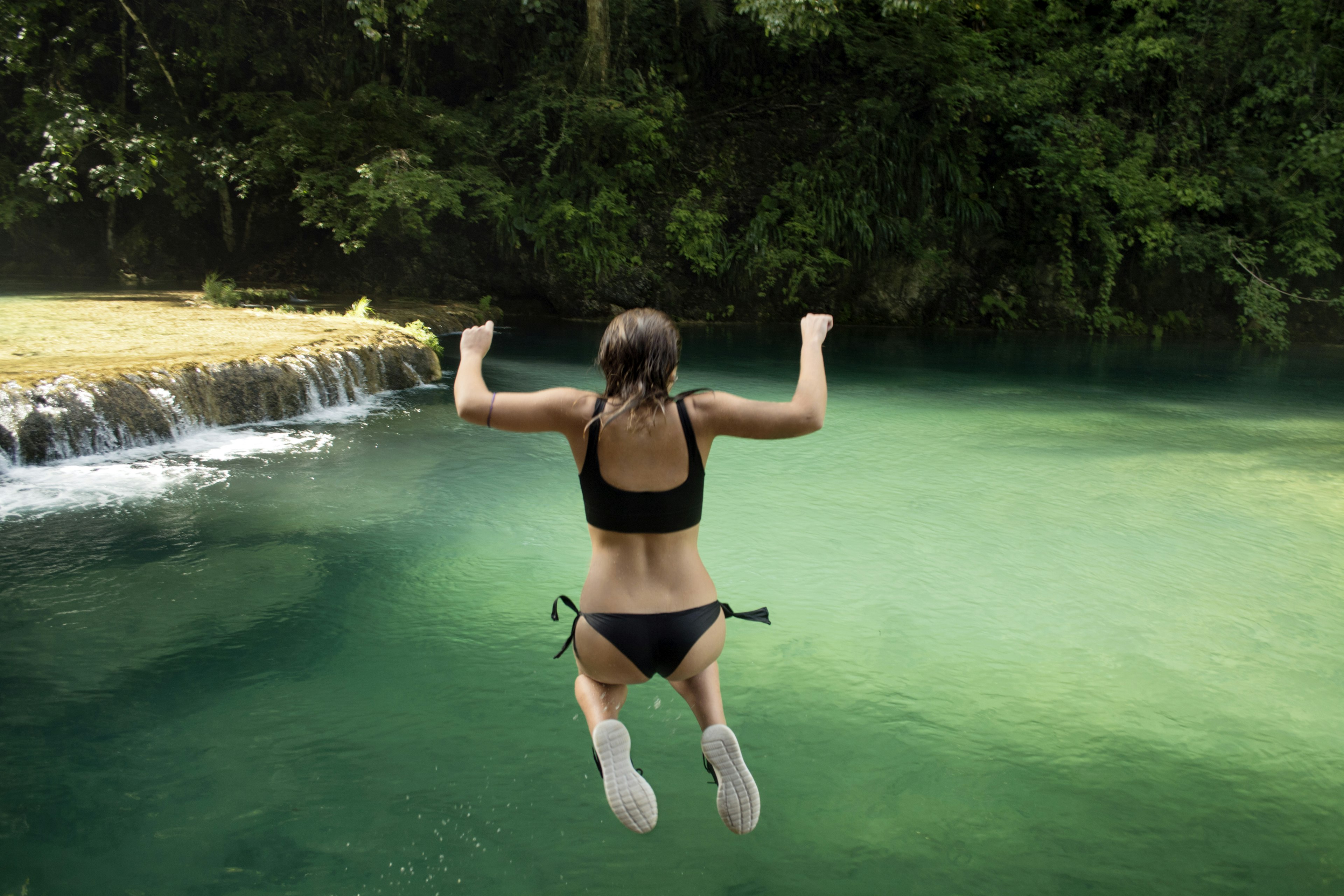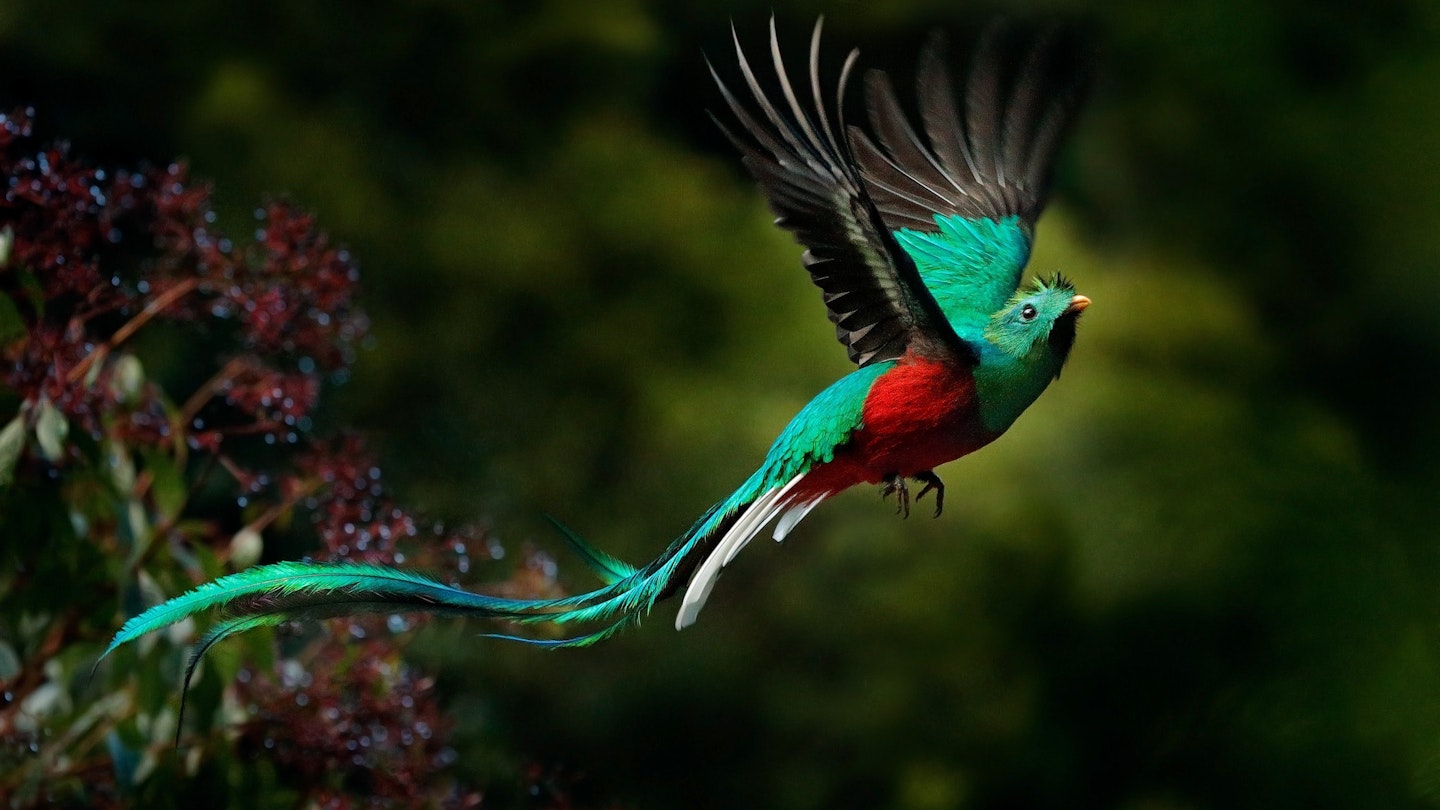Exploring the Best National Parks in Guatemala
- History lovers should head to Parque Nacional El Mirador
- Hike a rumbling volcano at Parque Nacional Volcán de Pacaya
- Spot Guatemala’s national bird at Biotopo del Quetzal
- Take a relaxing boat tour at Parque Nacional Río Dulce
- Parque Nacional Semuc Champey is the best national park for water lovers
- Enjoy top-notch swimming and camping at Parque Nacional Laguna Lachuá
- Parque Nacional Tikal is Guatemala’s best national park
Guatemala is brimming with diverse wildlife, tropical rainforests, and some of the oldest and most awe-inspiring ruins in the world. Whether you want to trek through the jungle trying to spot an elusive jaguar or climb an active volcano to roast marshmallows over cooled lava, Guatemala has no shortage of outdoor activities for nature lovers.
The largest protected area in the country is the Maya Biosphere Reserve, located in the northern region of El Petén, where national parks and reserves contain vast swaths of rainforest. Some are easy to access, like the iconic Tikal; others are for the truly intrepid, like the remote ruins of El Mirador, which requires a five-day trek through the jungle. Whatever level of adventure you seek, this part of the country is where the majority of Guatemala’s biodiversity thrives, and it shouldn’t be missed.
History lovers should head to Parque Nacional El Mirador
In 1926, pilot Charles Lindbergh flew over the dense jungle in northern Guatemala, noticing what appeared to be volcanoes rising from the trees. Upon closer inspection, the ruins of El Mirador revealed a city older than Tikal, thriving over 2000 years ago and potentially the first state-level society in the Western Hemisphere. The park features La Danta, one of the world’s largest pyramids by volume, alongside ancient art depicting scenes from the Popol Vuh, a vital sacred text of the Maya.
The jungle surrounding these ruins boasts considerable diversity, encompassing five types of tropical forest draped with towering ramon and sapodilla trees. Jaguars, pumas, and a variety of migratory birds, including the orange-breasted falcon and rare harpy eagles, also inhabit this region. However, the El Mirador ruins can only be accessed via a five-day jungle trek or by private helicopter from the small town of Carmelita near Flores in El Petén.

Hike a rumbling volcano at Parque Nacional Volcán de Pacaya
Standing at 2552m (8372ft), Volcán Pacaya is Guatemala’s most popular hike—and it’s easy to see why. Considered one of Central America’s most thrilling volcano treks, this active mountain is safe to climb; visitors can even roast marshmallows over cooled lava at the summit. Moreover, Pacaya is a fantastic day trip from either Guatemala City or Antigua. Its well-maintained trails, accompanied by clear signage, public restrooms, and vendors offering snacks, make it an accessible hike for all.
The trail winds through enchanting forests and picturesque farmland before unveiling extensive cooled lava fields near the peak. Horse rentals are available for those who prefer a gentler ascent. Consequently, no matter how you tackle Pacaya, the breathtaking views of neighboring volcanoes Agua, Fuego, and Acatenango are absolutely rewarding.
Spot Guatemala’s national bird at Biotopo del Quetzal
The stunning red-and-teal quetzal stands as Guatemala’s national bird, revered long before the arrival of conquistadors. Murals and tattoos of quetzals are commemorated throughout the nation, and Guatemala’s currency even pays tribute to this iconic species. If you aspire to see one in its natural habitat, a visit to the Biotopo del Quetzal south of Cobán is essential.
Although spotting a quetzal can be somewhat luck-based, this 2580-acre park offers the best chance in the country. It is explicitly dedicated to conserving cloud forests and the diverse wildlife within, including the quetzal, which is regrettably endangered. The park features two moderately challenging trails—one stretching 2km (1.2 miles), and the other at 4km (2.5 miles)—that lead you through an area teeming with ferns, bromeliads, and orchids. Additionally, the pine, cypress, and eucalyptus trees attract numerous tropical birds, including the emerald toucanet and forest falcons. At the trails’ end, refreshing waterfalls provide a splendid spot to unwind before heading back. The best time to witness quetzals is during March or June, prior to or following their nesting season.
Take a relaxing boat tour at Parque Nacional Río Dulce
Comprising a 30km (18.6-mile) river adorned with water lilies alongside 18,000 acres of wetlands, Río Dulce National Park on the Caribbean coast is best explored by boat. Tours departing from the town of Río Dulce consist of a leisurely two-hour ride, ripe with opportunities to observe wildlife along the banks. The park’s mangroves are home to crocodiles and represent one of the last habitats for the endangered manatee. Amongst the stunning scenery, the jungle canyon at the river’s end is a popular destination for bird-watchers hoping to glimpse hawks, herons, egrets, and kingfishers.
As you travel further, you will encounter La Cueva de la Vaca, a striking rock face draped in lush greenery and bromeliads—perfect for a photo op. Those keen for an immersive experience can spend the night in one of the jungle lodges on the Río Tatin, a tributary located just upstream from the canyon.

Parque Nacional Semuc Champey is the best national park for water lovers
Nestled deep within the jungles of Alta Verapaz, Semuc Champey comprises a stunning series of tiered turquoise pools resting atop a natural limestone bridge that covers the Cahabón River. This park is one of Central America’s most breathtaking locations, and while getting there involves various modes of public transportation, the effort seriously pays off.
Within the park, a 30-minute trek leads through rich vegetation filled with butterflies, tropical birds, and darting iguanas, culminating in a viewpoint that offers spectacular vistas of the pools nestled below in the lush gorge. This park invites visitors to linger, swim, sunbathe, and soak in the beauty. While not directly part of the park, many tours offer visits to the nearby K’anba Caves, featuring candle-lit swims through the enchanting underground river cave system.
Enjoy top-notch swimming and camping at Parque Nacional Laguna Lachuá
This vibrant tropical forest in Alta Verapaz provides the serene and crystal-clear Laguna Lachuá, known for its stunning turquoise color and extensive wooden dock, ideal for swimming. To reach the lagoon, visitors must navigate the park’s 5km (3-mile) trail through subtropical humid rainforest filled with diverse flora and fauna. Wildlife encounters are common, with opportunities to spot hummingbirds, tapirs, and even tarantulas.
Upon arrival at the lagoon, visitors can observe various marine birds, including storks, ducks, pelicans, egrets, and herons. This park is a popular overnight destination due to its campsite adjacent to the lagoon complete with a palapa for shelter during inclement weather. Facilities include washrooms and a communal cooking area, overseen by a dedicated park ranger available 24/7 for emergencies. Importantly, rules to protect the lagoon include prohibitions on bug repellent, soaps, and chemical sunscreens while swimming, as well as a ban on fishing and alcohol consumption within the park.

Parque Nacional Tikal is Guatemala’s best national park
It is indisputable: Tikal should be atop your list of places to experience in Guatemala. Once the centerpiece of the Maya civilization, this remarkable ancient city was rediscovered in 1848, with robust excavations commencing in 1951.
Covering 575 sq m (6189 sq ft), Tikal houses over 200 structures, some still largely enveloped by the jungle. The city flourished during the 7th century and is a profound testimony to the Maya society’s extraordinary sophistication. Notable structures include residential homes, royal palaces, administrative buildings, and several temples and pyramids, with Templo IV standing at 65m (213ft)—an unforgettable point for sunrise views.
As a Unesco World Heritage Site, Tikal possesses unique cultural and ecological significance. Visitor experiences may include encounters with jaguars and pumas at night and spotting an array of tropical birds during the day, such as hummingbirds, parrots, and toucans. Wandering through the jungle, listening to howler monkeys, and marveling at towering ceiba trees are as mesmerizing as the ruins themselves.
Most historians attribute the city’s abandonment to drought and deforestation, yet the exact reasons behind the decline of Tikal remain ambiguous, ultimately enhancing its allure and the mysteries surrounding the Maya civilization.





